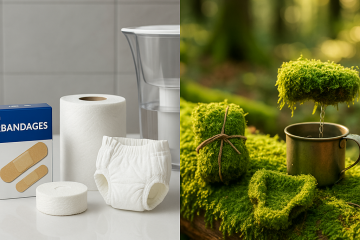
Trash Talk in a society down scenario
The Day the Trash Stopped Coming: Sanitation in a Long-Term Crisis
Picture this: It’s a Tuesday morning. You shuffle out to the curb in your fuzzy slippers, dragging that heroic black trash bag full of last week’s pizza boxes, dryer lint, and the mysterious thing in your fridge that’s been evolving into its own ecosystem. You plop the bag down, wave to your neighbor, and feel smug about being a functioning adult.
But then…nothing. No rumbling garbage truck. No friendly sanitation worker hanging off the back like Batman with a day job. Just silence. And by Thursday, your curb looks like a raccoon block party, complete with Uncle Steve the Trash Panda singing karaoke from inside your recycling bin.
Sounds funny—until you realize that in a long-term crisis, sanitation isn’t just about the stink. It’s about disease, pests, water contamination, and whether you’ll still have friends who can stand within five feet of you. When the trash stops coming, society doesn’t smell like roses. It smells like, well…garbage.
The Gross Factor Nobody Wants to Think About
We tend to prep food, water, and flashlights because they’re the Pinterest-worthy parts of preparedness. But garbage? Waste? Sewage? That’s the backstage crew no one claps for—until they don’t show up and the show goes downhill fast.
Without a sanitation plan, you’re rolling out the welcome mat for flies, rats, and bacteria with names that sound like failed Star Wars villains: E. coli, Salmonella, and Campylobacter. (Seriously, tell me that last one doesn’t sound like a Jedi reject.)
Trash Talk: Handling the Pile-Up
So what do you do when the garbage collectors are on an involuntary, world-ending strike?
-
Separate the enemies. Keep food scraps separate from regular trash. Organic waste attracts critters faster than a free buffet at Golden Corral. Compost what you can, but keep it covered and away from your water source unless you’re into “Eau de Rot” as a new cologne.
-
Contain the chaos. Use heavy-duty contractor bags, buckets with lids, or even old barrels. The tighter the seal, the fewer pests you’ll entertain. Bonus: raccoons hate padlocks.
-
Burn (responsibly). In rural or desperate scenarios, burning non-toxic trash may be an option. Just don’t toss in plastics unless you’re trying to invent a new flavor of lung disease.
When Recycling Becomes Survival Gear
When the trucks stop hauling, recyclables are no longer clutter—they’re raw materials in your own mini junkyard Home Depot. Here’s how to make them pull their weight:
Plastic Bottles & Jugs
-
Poop Insurance: Line a 2-liter bottle with sand and charcoal = DIY water filter. Because Giardia doesn’t care how organic your kale is.
-
Rodent Defense: Cut into strips and nail them around garden beds. Mice hate climbing razor-edge plastic more than Steve hates paying alimony.
-
Lighting Hack: Fill clear bottles with water + bleach, stick them in a roof hole = “bottle lightbulb” that refracts sunlight indoors. Yes, you can literally light your house with garbage.
Glass Jars & Bottles
-
Reusable Mason Jar 2.0: Canning, dry goods storage, or keeping your sourdough starter alive through the apocalypse. Glass doesn’t care if Amazon Prime is down.
-
Perimeter Alarms: Tie bottles on string across entry points. When something bumps, it clinks louder than Steve complaining about his ex-wife’s new boyfriend.
Metal Cans
-
Portable Grill: Punch some holes, flip it over, and you’ve got a hobo stove. Suddenly, your “trash” is a steak station.
-
Homemade Nails & Hooks: Flatten the can, cut strips, bend into makeshift hooks for hanging gear. Not pretty, but neither is trench foot.
-
Noise Grenades: Fill with rocks, tie to a tripwire. Nothing says “stay out of my beans” like an impromptu maraca symphony at 3 a.m.
The trick? Stop seeing “recyclables” as soda bottles and soup cans. Start seeing them as survival parts waiting for their audition in Prepper MacGyver: The Musical.
The Throne Room Situation
Trash is one thing. Human waste is another. The Romans figured out aqueducts, and we figured out flush toilets—but both require infrastructure that goes “poof” in a crisis.
-
The Porta-Potty Principle. A 5-gallon bucket + heavy-duty trash bags + a sprinkle of sawdust, kitty litter, or lime = an instant emergency toilet. Dignity sold separately.
-
Location, location, location. Designate one spot outside for waste disposal if you’re digging a latrine. Keep it at least 200 feet away from your water supply, unless you want your drinking water to come with “hints of Tuesday taco night.”
-
Hand hygiene = hero status. Soap, hand sanitizer, and a solid washing routine keep disease at bay. Skip this step, and you’ll be reminiscing about indoor plumbing while doubled over with dysentery.
Why Sanitation Is Survival
Food and water may keep you alive, but sanitation keeps you from wishing you weren’t. A long-term crisis without a sanitation plan is basically auditioning for the world’s worst episode of Hoarders.
The empowering part? You don’t have to live in a house of horrors. With a few buckets, bags, and a system in place, you can keep your space livable, your family healthy, and your nose unassaulted.
Final Flush
Preparedness isn’t just about stockpiling beans and rice. It’s about preserving dignity, health, and sanity when the systems we take for granted suddenly stop. So while it may not be glamorous, a sanitation plan is the unsung hero of your preparedness toolkit.
Because let’s be real: nobody wants their legacy to be “The Neighbor Who Smelled Like a Dumpster Fire.”


